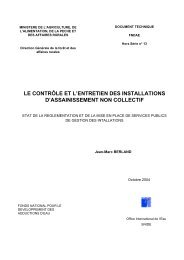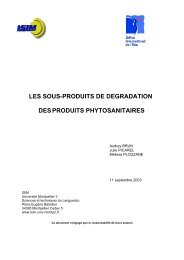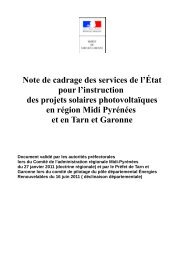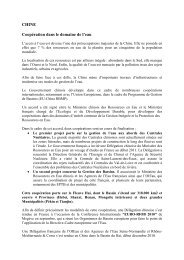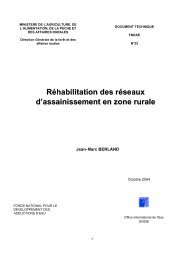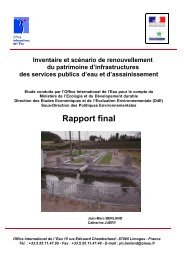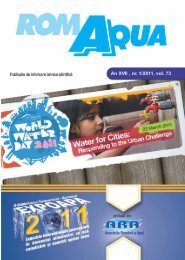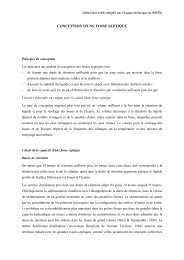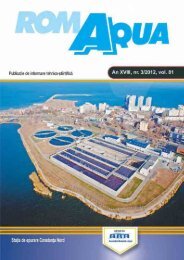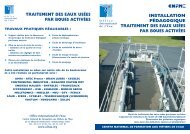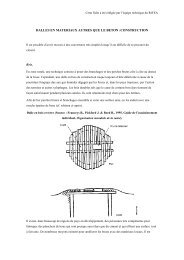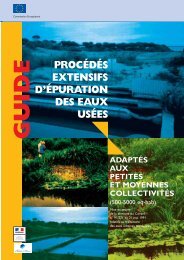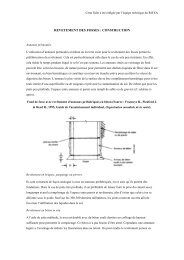vol 77 n° 5 2011 - Office International de l'Eau
vol 77 n° 5 2011 - Office International de l'Eau
vol 77 n° 5 2011 - Office International de l'Eau
Create successful ePaper yourself
Turn your PDF publications into a flip-book with our unique Google optimized e-Paper software.
STUDII SI CERCETARI<br />
Pilot project for <strong>de</strong>velopment of an intake management system<br />
of the Prut and moldova river in iaşi<br />
râului Prut, ca apă brută, într-un punct amplasat<br />
lângă satul Ţuţora. Apa brută captată aici este transportată<br />
direct în staţia <strong>de</strong> tratare Chiriţa, sau in<br />
Lacul Chiriţa, care acţionează ca bazin tampon şi ca<br />
bazin <strong>de</strong> pre-<strong>de</strong>cantare. Lacul Chiriţa poate asigura<br />
consumul oraşului Iaşi pe o perioada <strong>de</strong> circa 7 zile,<br />
în cazul în care alimentarea din Prut e scoasă din<br />
funcţiune. Sistemul <strong>de</strong> captare poate fi pus in pericol<br />
<strong>de</strong> poluările din amontele râului Prut (Ucraina,<br />
Moldova şi nordul României), poluări ce pot fi produse<br />
<strong>de</strong> pestici<strong>de</strong>, substanţe chimice şi alţi poluanţi,<br />
pe perioa<strong>de</strong> în<strong>de</strong>lungate. În acest moment nu se<br />
acordă aproape nici o atenţie pestici<strong>de</strong>lor şi substanţelor<br />
chimice care ar putea ameninţa sistemul<br />
<strong>de</strong> captare şi, mai <strong>de</strong>parte, întreaga aprovizionare<br />
cu apă potabilă a aglomerării Iaşi. Pestici<strong>de</strong>le nu<br />
sunt analizate în mod regulat si, prin urmare, doar<br />
un număr mic <strong>de</strong> analize este disponibil. Datele disponibile<br />
sunt relativ vechi (1994 - 1999) si toate analizele<br />
au fost efectuate <strong>de</strong> către ICIM Bucureşti.<br />
După cum se poate observa din tabelul 1, încărcările<br />
cu pestici<strong>de</strong> raportate în 1999 sunt semnificativ mai<br />
mari <strong>de</strong>cât valorile respective raportate pentru anii<br />
1994 - 1996. În timp ce parametrul “pestici<strong>de</strong> totale”<br />
raportat pentru anii 1994 - 1996 se încadrează în categoria<br />
A1 (1), concentratiile <strong>de</strong> pestici<strong>de</strong> găsite în<br />
1999 atribuie apei brute calitatea A3, ceea ce înseamnă<br />
necesitatea realizării unei tratări mai avansate, <strong>de</strong><br />
exemplu, cum ar fi cu adsorbţie pe cărbune activ<br />
granulat (pentru a atinge calitatea conformă a apei<br />
potabile). Datorită faptului că numărul <strong>de</strong> date<br />
<strong>de</strong>spre calitate, referitoare la pestici<strong>de</strong>, este foarte<br />
limitat, iar nivelurile raportate arată o distribuţie<br />
largă, semnificaţia rezultatelor disponibile este limitată.<br />
În amonte, în Ucraina, exista două oraşe importante:<br />
Kolomia (61.000 <strong>de</strong> locuitori, cu o staţie <strong>de</strong><br />
epurare nefuncţională) şi Cernăuţi, cu peste 240.000<br />
<strong>de</strong> locuitori şi activităţi industriale in domeniul produselor<br />
alimentare, textile, metalurgie, materiale<br />
plastice.<br />
Pe malul stâng al Prutului (în Republica Moldova),<br />
nr.5 / <strong>2011</strong> www.romaqua.ro<br />
– 1999) and all analyzes have been carried out by<br />
ICIM Bucharest (research Institute). As can be seen<br />
in the , the pestici<strong>de</strong> levels reported for the year 1999<br />
are significantly higher than the respective values<br />
reported for the years 1994 to 1996.<br />
While the parameter total pestici<strong>de</strong>s reported for<br />
the years 1994 to 1996 falls within category A1 (1),<br />
the pestici<strong>de</strong> levels found in 1999 characterize the<br />
raw water as A3 quality, which means that a more<br />
intensive treatment is required, e.g. an activated carbon<br />
adsorption process has to be implemented to<br />
achieve a sufficient drinking water quality. Due to<br />
the fact that the number of quality data related to<br />
pestici<strong>de</strong>s is very limited and the reported levels<br />
show a broad distribution, the significance of results<br />
is limited.<br />
Upstream in Ukraine, two cities of importance<br />
exist: Kolomyia (61,000 inhabitants with a malfunctioning<br />
WWTP) and Chernivtsi, with over 240,000<br />
inhabitants and industrial activities: food, textile,<br />
metallurgy, plastics.<br />
Upstream at the left bank (Republic of Moldova)<br />
are some small agglomerations and one city of importance:<br />
Ungheni (around 32,000 inhabitants). According<br />
the Environmental Assessment National Water<br />
Supply and Sanitation Project of the Republic of<br />
Moldova (E1823, Final Report, March 05, 2008) the<br />
WWTP of Ungheni is in a poor condition and needs<br />
to be refurbished. The city is located upstream the<br />
Prut River in relation to Iaşi. The effluent from the<br />
malfunctioning WWTP is discharged into the Prut.<br />
A visit to Ungheni during the preparation phase <strong>de</strong>livered<br />
the commitment of the Moldova Water<br />
Company to share Prut data. Contrary to <strong>de</strong>sktop<br />
study findings, the discharge of the effluent of the<br />
WWTP is downstream the intake of APAVITAL.<br />
However, downstream raw water intake stations<br />
will be affected by the poorly treated waste water<br />
from Ungheni.<br />
The Moldova River (237 km) rises from the Obcina<br />
Fere<strong>de</strong>u Mountains of Bukovina in Suceava County<br />
13



